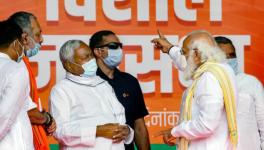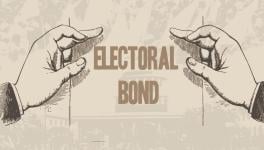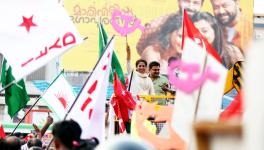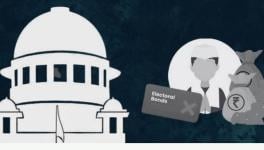Where is the Empowered Hindu?

Representational Image (PTI)
As we are inching forward to the next general elections in May, the Narendra Modi government is set to complete two terms in office. It is widely believed that India has become an `ethnic democracy` and it’s only a matter of time that it is formally declared to be a Hindu Rashtra.
What is understood by Hindu Rashtra is a religious majoritarianism that empowers the majority and disempowers or reduces religious minorities to a secondary status. For instance, in South Africa, under the apartheid regime, it was characterised by basskapp, which literally means boss-ship that ensured that politically, economically and socially, the minority Whites dominated over the majority Black community. It is a system of preferential treatment, segregated living and discriminatory rights regime.
Ethnic democracy also means unquestioned dominance of the core ethnic group, the way it is, for instance practiced in Israel.
However, India’s case doesn’t seem to fit either a majoritarian ethnic model of democracy or the apartheid system. Indian majoritarianism is a queer case, where there is a visible disempowered religious minority but no empowered ethnic majority. There is a discriminated Muslim but where is the empowered majority?
Indian majoritarianism, instead, replicates the caste-based model of ‘graded inequalities’. It is about symbolic inclusion through concrete exclusions that results in exclusion of the majority in a graded manner. Indian majoritarianism is against the majority and not just the minority. There is a discriminated, vulnerable and threatened Muslim without an empowered Hindu.
A Hindu can only feel empowered in ‘seeing` the excluded minority and beyond that Hindu, too, is as, if not more, vulnerable as the minority. When migrants walked back thousands of kilometres (during the pandemic-induced lockdown), most of them were Hindus, in which close to 40% were OBCs (Other Backward Classes,) but was there a preferential treatment for them?
Further, during the pandemic, while Muslims and Tablighi Jamaat (an evangelical Muslim group) were blamed for spreading the virus, there were no special arrangements for Hindus. Most of those who died, about 50 lakh, as per the World Health Organisation (WHO), were Hindus, but the deaths were denied, false data floated, and further ‘empowered’ and `dignified` as Hindus following traditional rituals when bodies were spotted floating on the banks of river Ganges.
The same methods were used to suppress the minorities through the use of rumours, false claims, exaggeration of conflict, and fake news in managing the crisis of governance, including the pandemic and the economy.
In the policy frame, too, the method of legislation remains somewhat same for both the minorities as well as the majority.
With Triple Talaq, Muslim men were criminalised but no alimony was provided for Muslim women. The regime ostensibly reached out to Muslim women through Triple Talaq and Uniform Civil Code, even as they garlanded the rapists of Bilkis Bano.
It was a similar case with the protesting wrestlers from Haryana against repeated molestation; they were left to languish on the streets of Delhi when the regime was busy carrying out campaigns for `Beti Bachao, Beti Padhao`.
The ruling Bharatiya Janata Party (BJP) made a pitch for Pasmanda Muslims and potential policy provisions for them, even as the data shows most of the victims of mob lynching were Pasmanda Muslims.
The said, the method seems to get replicated in policies, such as the EWS (Economically Weaker Sections), which provides an income cap of Rs 8 lakh and could potentially include 90% of the upper castes (though we have no concrete data on this), and thereby the same lot gains employment and admission to educational institutions, which they would have gained even otherwise.
But what EWS does is to proactively exclude Scheduled Castes, Scheduled Tribes and OBCs from being included in EWS. Exclusion is real, inclusion is symbolic.
When farmers hit the streets initially against the farm laws and now for legal protection of Minimum Support Price for crops, the protesting farmers, because majority happen to be Sikhs, were declared to be potentially driven by the demand for Khalistan; they were called ‘Khalistanis’. But this did not mean there would be separate provision for `Hindu` farmers. In fact, `Hindu` farmers became Jats and BJP went on to chart out a new strategy for the Jat-dominated areas of Western Uttar Pradesh and Haryana. They began to lay emphasis on consolidating OBCs, as against the dominant position of the Jats. From Hindus they became Jats, from Jats they became oppressors of OBCs.
Where is Hindu unity here? OBCs are being consolidated by being segregated into dominant and non-dominant OBCs. Lower end-OBCs are being mobilised against the dominant sections and dominant OBCs, such as the Yadavs are being mobilised against Dalits and Muslims.
The overall strategy, whether with Muslims or the castes within Hindus, remains the same. It is symbolic/psychological inclusion/empowerment against concrete exclusions. What is real in all of this is exclusion.
Indian majoritarianism excludes the majority. It is instead creating a system of oligarchy where power is extremely centralised in all its dimensions. In economy, power is centralised around select business houses, political power is centralised around two individuals and social and cultural power with one organisation.
India`s ethnic democracy has no ethnic core it privileges. It instead seems to require a disempowered majority in order to be manufactured into a majority in the first place. The manufactured or imagined majority becomes concrete in concrete exclusion found in law and economy. This creates a systemic vulnerability and institutionalised dependence on a predatory State. One is dependent on the same entity that is targeting you. It is this self-perpetuating circularity that ironically allows for a sense of being a majority.
The terms of reference in a democracy shift dramatically from one of progressive expansion of freedoms and inclusion to one of perpetual vulnerability necessarily demanding exclusion. Exclusion becomes a structural necessity that finds a political articulation. Predatory state becomes a structural condition to exist. Predatory state succeeds and draws legitimacy by diverting demands against it through a rights language to management of conflicts between social groups. State and leader become omnipresent and beyond legitimacy. Leader is beyond a contract, moving close to the `original` divine theory of State.
Every expression of dissent becomes illegitimate as it disturbs the foundations of the manufactured and imagined majority. The Leader becomes the default personification of the majority. The disempowered majority also becomes a necessary condition for the majority to exist, come into being and sustain itself.
Get the latest reports & analysis with people's perspective on Protests, movements & deep analytical videos, discussions of the current affairs in your Telegram app. Subscribe to NewsClick's Telegram channel & get Real-Time updates on stories, as they get published on our website.
























